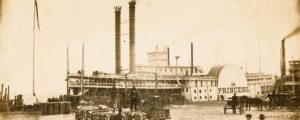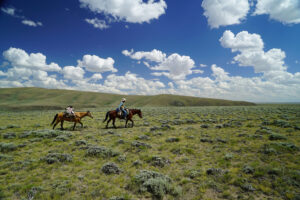Six fur trade rendezvous were held near present-day Pinedale.
The Green River springs from the Wind River Range along the Continental Divide and meanders down through the Green River Valley, just west of modern-day Pinedale, Wyoming. It is there, at the confluence of the Green River and Horse Creek, that the legendary 19th century mountain men held many of their Rocky Mountain rendezvous and where a museum honors them today.
At 7,200 feet, hemmed in by three mountain ranges (Wind River, Wyoming and Gros Ventre), the Museum of the Mountain Man attracts a wide variety of visitors to the rural ranching community of Pinedale. Stunning relics and period pieces are only part of the attraction; visitors may also attend lectures by experts on the mountain man era. Of the 15 Rocky Mountain rendezvous, six of them (1833, 1835, 1836, 1837, 1838 and 1840) were held in the Green River Valley. These annual wilderness trade fairs brought together fur trappers, Indians and buyers to exchange beaver pelts for tobacco, firearms, ammunition, beads and whiskey. Drinking, gambling and womanizing comprised unofficial business at these raucous gatherings.
In October 1811, 61 Astorians of the American Fur Company, led by Wilson Price Hunt, are believed to have been the first white men to enter the Green River Valley, which would remain one of the richest beaver-hunting grounds in the West until the fur trade ended in 1840. Crossing Union Pass and descending into the valley, they opened the door to trapping not only on the Green River (which flows into the Colorado), but also on the Wind and Bighorn rivers (which flow into the Yellowstone) and the Snake River (which flows into the Columbia). The Rocky Mountain rendezvous system, initiated by fur trade pioneer William Henry Ashley, eliminated the need for remote trading posts, allowing mountain men, Indians and the fur company men to conduct business at the source. Though this trade no doubt paved the way for the settling of the West, many mountain men were said to have “gone Indian,” and some felt out of place in polite white society.
Fourteen miles west of the museum is the site of Fort Bonneville, an early fur-trading stockade, erected in 1832. A 1989 excavation of the site uncovered many artifacts now on display at the museum. Just outside the museum entrance itself stands a brain-tanned buffalo-hide tepee 20 feet in diameter. Hand-made by historian and ethnologist Michael Terry, it is a replica of Sioux Chief American Horse’s tepee, captured at the September 1876 Battle of Slim Buttes. (The original is at the Smithsonian in Washington, D.C.) The tepee contains buffalo robes, a hand-painted drum, headdresses, a buffalo bull neck shield, bows and arrows, a war lance and smoking pipes.
Among the more interesting exhibits is a .40-caliber half-stock rifle that mountain man Louis Vasquez presented to his friend and business partner Jim Bridger. The museum showcases many other firearms and personal items from the era, including belt hatchets, bone-handled knives, elk antler dice, playing cards and “possibles sacks” (which might hold rope, tobacco and a clay pipe, or a powder horn, gunpowder and a bullet mold).
Beavers, whose pelts were the basis of the fur trade, get their just due in several displays about the furry beasts and their habitat. Of particular interest are the beaver presses, made of local timber and used by trappers to compress pelts into 100- pound bales for transport. Visitors can also admire the fruit of the mountain man’s labor—the felted beaver top hat. Tribes that participated in the fur trade included the Shoshones, Crows, Arapahos, Utes and Blackfeet, and the museum displays their clothing, beads, cooking implements, baskets, bowls, tools and weapons. Another exhibit features maps and books from the period.
You don’t have to be a modern-day mountain man to appreciate a museum dedicated to the likes of Ashley, Bridger, Kit Carson, Jedediah Smith, James Beckwourth, Thomas “Broken Hand” Fitzpatrick and Joe Meek. Supported by the Sublette County Historical Society, the Museum of the Mountain Man, at 700 E. Hennick in Pinedale, is open daily from 10 a.m. to 5 p.m. between May 1 and September 30, weekdays until 4 p.m. in October and by appointment in winter. Visit www.museumofthemountainman .com or call 877-686-6266.
Originally published in the April 2009 issue of Wild West. To subscribe, click here.




